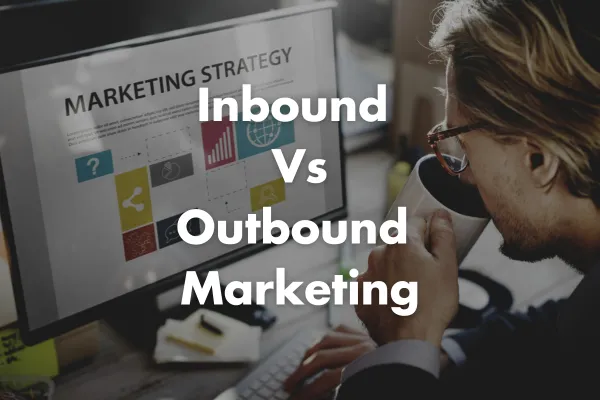Blog

What's the Difference Between Inbound and Outbound Marketing?
Inbound and outbound marketing are two distinct approaches to reaching and engaging customers, each with its unique strategies and methodologies:
Inbound Marketing
Attracts Customers: Inbound marketing focuses on creating content or experiences tailored to the interests and needs of potential customers, attracting them towards the company or product.
Permission-Based: This approach often relies on gaining permission from the audience to send them information, such as through email subscriptions or following on social media.
Content-Driven: Inbound marketing is heavily reliant on content creation – blogs, videos, podcasts, social media posts, etc. – which is designed to be valuable and engaging to the target audience.
Interactive and Educational: It tends to be more interactive, often involving educational materials, webinars, or helpful tools that engage the audience and solve their problems.
Digital Focus: Inbound strategies are primarily executed online, utilizing SEO, social media, and content marketing to draw in digital audiences.
Customer-Centric: It is customer-focused, aiming to meet users at various stages of their buying journey with relevant and helpful information.
Builds Relationships: Inbound marketing aims to build a relationship with the audience over time, creating trust and brand loyalty.
Cost-Effective in Long Term: While it can take time to see results, inbound marketing is often more cost-effective in the long run, as it focuses on creating lasting relationships with customers.
Outbound Marketing
Pushes Products/Services: Outbound marketing involves pushing a message out to a large audience, often regardless of whether the audience has shown interest in the product or service.
Interruption-Based: This method can be seen as interruptive, as it involves reaching out to potential customers without their prior consent or interest.
Media and Advertising Driven: It heavily relies on traditional media such as TV ads, print ads, radio, direct mail, telemarketing, etc.
Broad Targeting: Outbound marketing often targets a broad audience, aiming to reach as many people as possible, in contrast to the targeted approach of inbound marketing.
Less Interaction: There's usually less direct interaction between the company and the consumer in outbound marketing, focusing more on one-way communication.
Product-Centric: It is often more product-centric, focusing on the features and benefits of the product or service being sold.
Quick Results: Outbound strategies can yield quicker results in terms of visibility and reach, but may not always result in immediate sales.
Higher Initial Costs: These campaigns can be expensive, requiring significant investment in media and advertising channels.
Inbound Marketing Strategies:
Content Marketing: Creating and distributing valuable, relevant, and consistent content to attract and engage a clearly defined audience, with the objective of driving profitable customer action.
SEO (Search Engine Optimization): Optimizing your website and content with relevant keywords to rank higher in search engine results pages (SERPs), making it easier for potential customers to find you.
Social Media Marketing: Using platforms like Facebook, Twitter, LinkedIn, and Instagram to create engagement, build community, and share valuable content to attract followers and convert them into customers.
Email Marketing: Sending targeted, personalized emails to a segmented list of subscribers to educate, inform, or offer solutions to their problems, thus nurturing leads into customers.
Blogging: Regularly publishing blog posts that provide valuable information or insights relevant to your target audience, establishing your brand as a thought leader in your industry.
Influencer Collaborations: Partnering with influencers or thought leaders in your industry to reach a broader audience and gain credibility through association.
Webinars and Online Workshops: Hosting online events to educate your audience about your industry or products, providing value and building relationships.
User-Generated Content: Encouraging customers to create content related to your brand, which can be shared on your platforms, creating authenticity and trust.
Referral Programs: Creating programs that incentivize current customers to refer new customers, leveraging word-of-mouth marketing.
Interactive Tools and Calculators: Developing online tools or calculators that provide value to your potential customers, encouraging engagement with your brand.
Outbound Marketing Strategies:
Cold Calling: Making unsolicited calls to potential customers to pitch your products or services.
Direct Mail: Sending physical mail, like postcards, brochures, or catalogs, directly to potential customers.
Traditional Advertising: Using traditional media like TV, radio, newspapers, and magazines to reach a broad audience with your marketing message.
Trade Shows and Conferences: Participating in industry events to showcase your products or services, network with potential clients, and build brand awareness.
Email Blasts: Sending a single email message to a large group of people, often a non-segmented audience, to promote a product, service, or event.
Print Advertising: Placing ads in newspapers, magazines, brochures, or other printed materials for distribution.
Telemarketing: Using telephone calls to directly market your products or services to potential customers.
Out-of-Home Advertising: Utilizing billboards, transit ads, and other outdoor media to reach consumers while they are outside their homes.
Paid Online Advertising: Using platforms like Google Ads or social media paid advertising to reach a targeted audience.
Door-to-Door Sales: Visiting potential customers at their homes or businesses to present and sell your products or services directly.
Conclusion
The key difference lies in their approach: inbound marketing pulls interested customers in, while outbound marketing pushes messages out to a broader audience. Inbound is more about building relationships and providing value, making it a more subtle and customer-centric approach, whereas outbound is more direct and product-focused, aiming for immediate visibility and reach.
Each of these strategies has its strengths and can be effective in different scenarios depending on your target audience and marketing objectives.

What's the Difference Between Inbound and Outbound Marketing?
Inbound and outbound marketing are two distinct approaches to reaching and engaging customers, each with its unique strategies and methodologies:
Inbound Marketing
Attracts Customers: Inbound marketing focuses on creating content or experiences tailored to the interests and needs of potential customers, attracting them towards the company or product.
Permission-Based: This approach often relies on gaining permission from the audience to send them information, such as through email subscriptions or following on social media.
Content-Driven: Inbound marketing is heavily reliant on content creation – blogs, videos, podcasts, social media posts, etc. – which is designed to be valuable and engaging to the target audience.
Interactive and Educational: It tends to be more interactive, often involving educational materials, webinars, or helpful tools that engage the audience and solve their problems.
Digital Focus: Inbound strategies are primarily executed online, utilizing SEO, social media, and content marketing to draw in digital audiences.
Customer-Centric: It is customer-focused, aiming to meet users at various stages of their buying journey with relevant and helpful information.
Builds Relationships: Inbound marketing aims to build a relationship with the audience over time, creating trust and brand loyalty.
Cost-Effective in Long Term: While it can take time to see results, inbound marketing is often more cost-effective in the long run, as it focuses on creating lasting relationships with customers.
Outbound Marketing
Pushes Products/Services: Outbound marketing involves pushing a message out to a large audience, often regardless of whether the audience has shown interest in the product or service.
Interruption-Based: This method can be seen as interruptive, as it involves reaching out to potential customers without their prior consent or interest.
Media and Advertising Driven: It heavily relies on traditional media such as TV ads, print ads, radio, direct mail, telemarketing, etc.
Broad Targeting: Outbound marketing often targets a broad audience, aiming to reach as many people as possible, in contrast to the targeted approach of inbound marketing.
Less Interaction: There's usually less direct interaction between the company and the consumer in outbound marketing, focusing more on one-way communication.
Product-Centric: It is often more product-centric, focusing on the features and benefits of the product or service being sold.
Quick Results: Outbound strategies can yield quicker results in terms of visibility and reach, but may not always result in immediate sales.
Higher Initial Costs: These campaigns can be expensive, requiring significant investment in media and advertising channels.
Inbound Marketing Strategies:
Content Marketing: Creating and distributing valuable, relevant, and consistent content to attract and engage a clearly defined audience, with the objective of driving profitable customer action.
SEO (Search Engine Optimization): Optimizing your website and content with relevant keywords to rank higher in search engine results pages (SERPs), making it easier for potential customers to find you.
Social Media Marketing: Using platforms like Facebook, Twitter, LinkedIn, and Instagram to create engagement, build community, and share valuable content to attract followers and convert them into customers.
Email Marketing: Sending targeted, personalized emails to a segmented list of subscribers to educate, inform, or offer solutions to their problems, thus nurturing leads into customers.
Blogging: Regularly publishing blog posts that provide valuable information or insights relevant to your target audience, establishing your brand as a thought leader in your industry.
Influencer Collaborations: Partnering with influencers or thought leaders in your industry to reach a broader audience and gain credibility through association.
Webinars and Online Workshops: Hosting online events to educate your audience about your industry or products, providing value and building relationships.
User-Generated Content: Encouraging customers to create content related to your brand, which can be shared on your platforms, creating authenticity and trust.
Referral Programs: Creating programs that incentivize current customers to refer new customers, leveraging word-of-mouth marketing.
Interactive Tools and Calculators: Developing online tools or calculators that provide value to your potential customers, encouraging engagement with your brand.
Outbound Marketing Strategies:
Cold Calling: Making unsolicited calls to potential customers to pitch your products or services.
Direct Mail: Sending physical mail, like postcards, brochures, or catalogs, directly to potential customers.
Traditional Advertising: Using traditional media like TV, radio, newspapers, and magazines to reach a broad audience with your marketing message.
Trade Shows and Conferences: Participating in industry events to showcase your products or services, network with potential clients, and build brand awareness.
Email Blasts: Sending a single email message to a large group of people, often a non-segmented audience, to promote a product, service, or event.
Print Advertising: Placing ads in newspapers, magazines, brochures, or other printed materials for distribution.
Telemarketing: Using telephone calls to directly market your products or services to potential customers.
Out-of-Home Advertising: Utilizing billboards, transit ads, and other outdoor media to reach consumers while they are outside their homes.
Paid Online Advertising: Using platforms like Google Ads or social media paid advertising to reach a targeted audience.
Door-to-Door Sales: Visiting potential customers at their homes or businesses to present and sell your products or services directly.
Conclusion
The key difference lies in their approach: inbound marketing pulls interested customers in, while outbound marketing pushes messages out to a broader audience. Inbound is more about building relationships and providing value, making it a more subtle and customer-centric approach, whereas outbound is more direct and product-focused, aiming for immediate visibility and reach.
Each of these strategies has its strengths and can be effective in different scenarios depending on your target audience and marketing objectives.
Book a Free Strategy Call Today!
No obligation, 15-Minutes that can change the future of your multifamily business!
@ Copyright 2020 Smart Syndicator - All Rights Reserved






